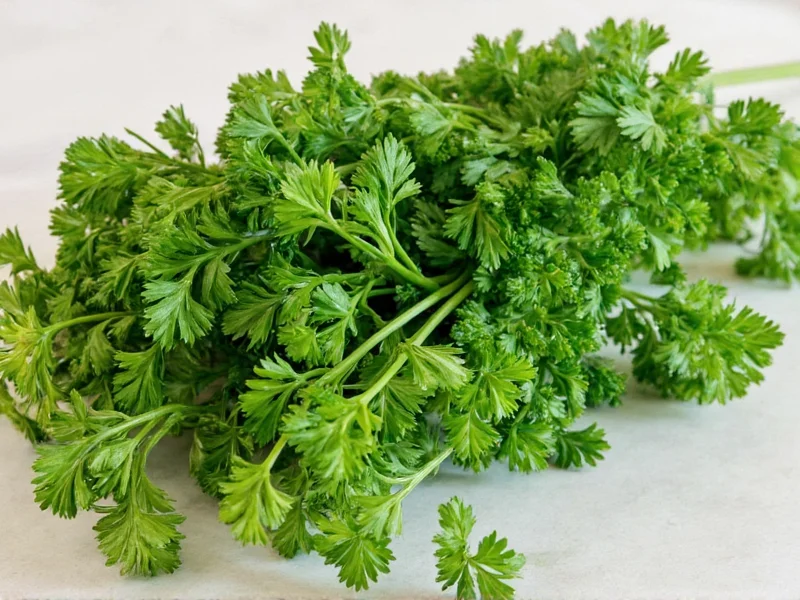1 teaspoon of dried parsley equals 1 tablespoon of fresh parsley. This 1:3 ratio accounts for the water loss during drying, which concentrates the dried herb's flavor. Understanding this conversion prevents over-seasoning and ensures balanced flavors in your dishes.
When you're mid-recipe and realize you're out of fresh parsley, knowing the exact dry to fresh conversion saves your dish. Many home cooks make the mistake of using equal measurements, resulting in either bland or overpowering flavors. The standard conversion ratio—1 teaspoon dried parsley to 1 tablespoon fresh parsley—is essential knowledge for anyone who cooks regularly.
Why Dried and Fresh Parsley Aren't Equal
Drying removes approximately 90% of fresh parsley's water content. This concentration means dried parsley packs more flavor per volume. Using equal amounts would make your dish three times too strong. The conversion ratio balances this intensity difference while maintaining the intended flavor profile.
The Science Behind Herb Conversion Ratios
When herbs dry, volatile oils become more concentrated as moisture evaporates. Fresh parsley contains about 85-90% water, while dried parsley drops to 5-10% moisture. This scientific reality explains why you need less dried herb to achieve equivalent flavor. The 1:3 ratio (dried:fresh) applies to most leafy herbs including cilantro, dill, and oregano.
Dry Parsley to Fresh Conversion Chart
| Dried Parsley | Fresh Parsley | Best For |
|---|---|---|
| ¼ teaspoon | ¾ teaspoon | Delicate sauces, dressings|
| ½ teaspoon | 1½ teaspoons | Soups, stews (long cooking)|
| 1 teaspoon | 1 tablespoon | Standard conversion for most recipes|
| 1½ teaspoons | 4½ teaspoons | Robust dishes, marinades|
| 1 tablespoon | 3 tablespoons (¼ cup) | Large batch cooking
Practical Substitution Tips
When substituting dried for fresh parsley, consider these professional cooking insights:
- Add dried herbs earlier: Incorporate dried parsley at the beginning of cooking to allow rehydration and flavor distribution. Fresh parsley typically goes in during the last few minutes.
- Adjust for dish type: Use 1:2.5 ratio for delicate dishes like fish or egg preparations where parsley flavor should be subtle.
- Taste as you go: Always taste before final seasoning, especially with dried herbs which can vary in potency based on age and storage.
- Reconstitute when possible: For dishes with short cooking times, soak dried parsley in 1 teaspoon warm water for 5 minutes before adding.
Common Conversion Mistakes to Avoid
Many home cooks make these critical errors when converting dry parsley to fresh:
- Equal measurement substitution: Using 1:1 ratio makes dishes overly herbal
- Ignoring recipe timing: Adding dried parsley at the same stage as fresh prevents proper flavor development
- Not accounting for age: Older dried herbs lose potency—use slightly more if your dried parsley is over a year old
- Overcompensating: When converting multiple herbs, apply the ratio individually rather than to the total herb amount
Flavor Profile Differences
While the conversion ratio provides equivalent flavor intensity, dried and fresh parsley have distinct characteristics. Fresh parsley offers bright, grassy notes with subtle peppery undertones, while dried parsley develops earthier, more concentrated flavors. In dishes where parsley is the star ingredient (like tabbouleh or chimichurri), fresh provides superior texture and aroma. For background seasoning in soups and stews, dried works perfectly with proper conversion.
Storage Tips for Maximum Freshness
Proper storage extends the usability of both forms:
- Fresh parsley: Store stems in water like flowers, covered with a plastic bag in the refrigerator (up to 2 weeks)
- Dried parsley: Keep in airtight container away from light and heat (6-12 months optimal freshness)
- Freezing fresh: Chop and freeze in oil cubes for ready-to-use portions that don't require conversion
- Reviving dried: If your dried parsley seems weak, toast lightly in a dry pan to reactivate essential oils
When to Make Exceptions to the Standard Ratio
While the 1:3 dry to fresh parsley conversion works for most applications, consider these exceptions:
- Long-simmered dishes: Use 1:2.5 ratio as prolonged cooking intensifies dried herb flavors
- Raw applications: For salads or garnishes, increase fresh amount by 25% since dried won't rehydrate
- Old dried herbs: If your dried parsley is over 12 months old, use 20% more to compensate for flavor loss
- Curly vs. flat-leaf: Curly parsley dries more intensely—use 1:3.5 ratio when substituting dried curly for fresh flat-leaf











 浙公网安备
33010002000092号
浙公网安备
33010002000092号 浙B2-20120091-4
浙B2-20120091-4